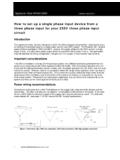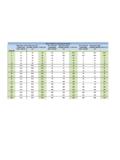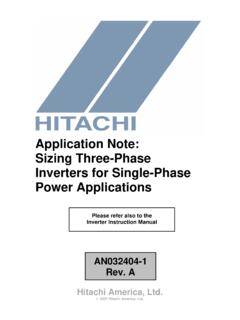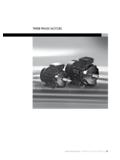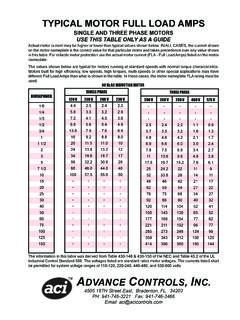Transcription of Three-Phase Transformers - EdRenzi.com
1 Three-Phase TransformersWhen more power is needed - three Transformers can be tied together. Thisis called Three-Phase . Here s a simple way of comparing single -phase to Three-Phase power. single -PhaseThree-PhaseThink of single -phase as one guy driving a stake into the ground; three -phaseas three guys, working together, driving the same stake into the three -PhaseThree-phase power is delivered from a generator with three separatewindings. These windings are equally spaced around a rotating cylinder (rotor)with each winding occupying one-third of the rotor circumference. three -phasegenerator windings are spaced 120 apart for a total of 360 . 120 120 120 Because the three source voltages timed at three different intervals, they canbe transmitted over just three conductors (rather than the six conductorsneeded to transmit three separate single -phase loads).
2 120 120 120 A Three-Phase system can produce 173% higher effective voltage than asingle-phase system. This is very useful for higher power loads such as largemotors. 26We calculate the total voltage (of all three lines of a Three-Phase trans-former) by multiplying the voltage of each single winding (phase) by the squareroot of 3 (!3). The reason for this is the angles of each phase are always 120 120 By using this trigonomic formula (don t get scared) we can see where wederive the square root of 120 --------- = = !3sin 30 ConnectionOne way of tying three Transformers together is in parallel (+ to +) and(- to -). This is called a Wyeconnection.
3 Here s how a Wye connection is wired:NeutralL1L2L3 LinePhase27We call each of the single -phase transformer windings (hooked together) of the three single -phase Transformers (L1-L2-L3) is called the Line. We really only draw Three-Phase from the Line side. Also,Line Amps on a Wye connected transformer equals Phase Amps. It would seemthat current would not remain the same in a parallel circuit. But, threetransformers wired in parallel are not like three resistors in produce, instead of consume voltages, so the opposite ruleswould would apply in this more simplified representation of a Wye looks like this:NL1L2L3 ABCIf we tie together three single -phase, 120 volt, Transformers in a Wyeconfiguration our output voltage would look like this:NL1L2120 v120 v120 v208 v3 L3 Why do we get 208 volts, Three-Phase on the Line side (L1-L2-L3) ?
4 Justmultiply 120 volts times the square root of 3 (!3). Remember phase angles ofthree 120 volt sources. 120 volts x (!3) = 208 volts28We can also get 208 volts, single -phase on the Line side of this transformerby connecting (L1-L2);NL1L2L3"A"120 v208 v1 "B"120 v"C"120 vAs you see, we are connecting only two of the three single -phasetransformers available. We still only get 208 volts (120 x !3) from thisconnection, and it is just single -phase. But, we have the capability of using twotransformers ( A & B ) to help share the load. Also, we can use two otherpossible connections (L2-L3) and (L1-L3) to feed other 208 volt, what ! Yes, it s even possible to get 120 volts, single -phase out of thesame "A"120 v120 v1 "B"120 v"C"120 vL3 Remember, we have the benefit of a neutral conductor and, by connecting(L2-N) we can feed 120 volt, single -phase loads.
5 And, seeing that we are onlyusing one single -phase transformer ( B ), that leaves two other possibilities (L1-N) and (L3-N) for serving other 120 volt circuits. What s also very useful is thatwe can balance three 120 volt circuits on just one other words, A208/120 volt (Wye configured) transformer could supply120 volt, single -phase equipment (like fluorescent lights), 208 volt, single -phase29equipment (like range or oven), and 208 volt, Three-Phase equipment (like heavymachinery). This is what makes Three-Phase so great !Delta ConnectionsAnother way of tying three Transformers together is in series (+ to -). This iscalled a Deltaconnection. Here s how a Delta connection is wired:L1L2L3 PhaseLineA more simplified representation of a Delta configuration looks like this:L1L2L3 ACB30By connecting three (240 volt) single -phase Transformers (Delta) we get 240volts, Three-Phase .
6 We don t multiply by !3 because Line volts equals Phasevolts on Delta Transformers . It would seem that voltage, would not remain thesame in a series type circuit. But, three Transformers wired in series are not likethree resistors in series. Transformers produce, (instead of consume) voltages,so the opposite rules would would apply in this v240 v240 vL3240 v3 Connect (L1-L2) and you ll get 240 volts, single -phase. Connecting (L2-L3)or (L1-L3) will also give us 240 volts, single -phase. Notice how three different240 volt (1 ) loads utilize three different v240 v240 vL3240 v1 We can still get 120 volts, ( single -phase) out of a 240 volt Delta system, butit s going to take some additional work.
7 We are going to have to center-tap oneof the 240 volt, single -phase Transformers . It s customary to center-taptransformer C ..L3L1L2"C"240 v120 v, 1 N120 v, 1 31As you can see, we can get 120 volts, ( single -phase) from a Deltaconfiguration (L2-N) (L3-N). Unfortunately, all 120 volt loads must be carriedon transformer C . Types Of Three-Phase TransformersWith the possibility of wiring both the primary and secondary of Three-Phase Transformers , there are four possible configurations:(1) Wye/Wyeis commonly used for interior wiring systems.(2) Wye/Deltais used to step-down utilities high line voltages.(3) Delta/Deltais often used for industrial applications.
8 (4) Delta/Wyeis popular for stepping down transmission lines to four-wire services when neutrals are most commonly used Three-Phase transformer is a Delta/Wyeconfiguration. It s used primarily for power distribution from utilities toresidential and commercial v480 v480 vL3NL1L2120 v120 v120 v208 v3 208 v1 120 v1 480 v3 PrimarySecondaryThe given voltage designations for a Delta/Wye Three-Phase transformer is: Primary-Line/Secondary-Line/Secondary-Ph ase Or in this case:Delta/Wye (480/208/120)32 Phase-To-PhaseLet s not forget that Three-Phase is a product of three individual single -phase Transformers . When calculating the Phase-To-Phaserelationship the samerules apply as any single -phase transformer.
9 In other words, Our Phase-To-Phase voltage below is 480 to 120 which is a ratio of 4 "A"480 v"B"480 v"C"480 v"A"120 v"A"120 v"A"120 vWe can also use the the same ladder chart we used for a typical x 480120 Don t forget that this is just one of three single -phase Transformers . Theremay be efficiency or power factor losses between the primary and secondaryphases. But, we ll assume that this transformer is 100% efficient with no powerfactor loss so the Primary vA will equal the Secondary the Primary vA, Primary Amps and Secondary Watts assumingthat our Secondary Amps = x 480120100 Did you get 12,000 Primary vA ? Multiplying 12,000 by 3 (threetransformers) will give us 36 kVa (36,000 vA).
10 We ll call this our Line kVa, whichis the sum total of all three - phases . In other words, our transformer rating is s important to understand the difference between Phase and Line. Phaseis the single -phase transformer relationship. Line is the result of the combinationof all three Transformers hooked are a few of rules we must remember. (1) Line Watts = Phase Watts x 3 (or) Phase Watts = Line Watts 3(2) Delta Phase Volts = Delta Line Volts(3) Wye Phase Amps = Wye Line AmpsYes, we can use the ladder Line-To-Line on Three-Phase Transformers Checkthis !3 !3 VAx!3 !348036,00020836,00010034 For example, knowing the values of Secondary Line Amps (100) andSecondary Line Volts (208) we would multiply going up the ladder to findSecondary Line Watts.


